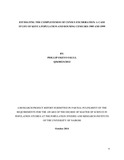| dc.description.abstract | This study explores trends in completeness of census data in Kenya for 2 successive inter-censal
periods of 1979-89 and 1989-99. The objective of the study was to estimate the completeness of
Kenya’s 1999 and 1989 censuses relative to the respective previous censuses and; to make
appropriate adjustments for coverage. The study utilized secondary data from the KNBS
population and housing censuses of 1999 and 1989. The main method of analysis involved the
Brass Growth Balance model to estimate completeness of the 1999 census relative to the 1989
census; and completeness of 1989 census relative to the 1979 census by age and sex. The African
Standard model life table was used to estimate mortality.
The results indicate that an overall decline in the level of completeness of census enumeration
from 1969-79 period up to 1989-99 inter-censal period. A common observation in both intercensal
periods is that ages 5-9, 10-14 and 50+ for both males and females have shown a
deviation from the line of best fit, indicating possible higher age misreporting and heaping
amongst these age groups. Female enumeration indicated lower levels than males in the three
inter-censal periods. These substantial sex differences in the degree of completeness could be
caused by similar sex differences in literacy rates, education, or other factors. For example,
women may be more likely to have their information reported by a proxy (such as the head of the
household) than men. Completeness of estimates of death on the other hand indicated an
improvement over time. However, large variations in the completeness of death estimates have a
relatively large effect on the estimated expectation of life at age 0 years. For example, a 78.7 per
cent lower completeness of death registration amongst females in 1989-99 decreases the
estimated e5 from 65.4 to 54.74 years, a drop of over 10 years. Adjustment of the inter-censal
age distributions for the Kenya population yields an adjusted exponential population growth rate
over the 1989-99 inter-censal period of 3.66% compared to the reported 3.09%; while the
adjusted exponential growth rate for the 1979-89 inter-censal period yields 4.2% compared to the
reported 3.4%.
The trends of adjusted mortality and age-sex di
results obtained in this study and the resemblance shows a high level of accuracy of the findings.
The assumption of none or negligible migration in this method is untenable in Kenya today,
given high net migration experienced over the years. Thus, further studies in this area ought to
consider adjusting the technique for migration as proposed by Hill and Queiroz (2004).
The diminishing level of data quality (less completeness) over time as seen in the findings of this
study implies that estimates of population growth rate could be inaccurate. This introduces a
need to consider possible explanations for the inaccuracies in the age-sex structure of the Kenya
population in addition to the summary of levels of completeness. Demographers and census
experts ought to consider re-examining data quality and institute specific measures to improve on
the same, particularly at age groups 5-9, 10-14 and 50+, based on the results of this study. Such
measures would ensure quality data for use in policy making and development planning | en_US |

